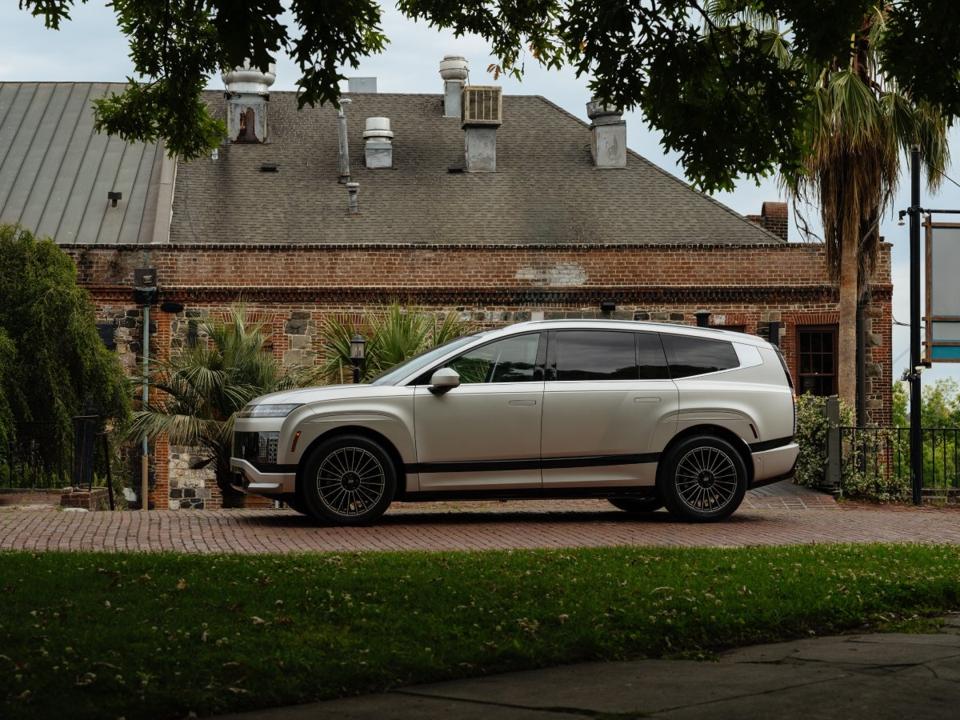It’s “thar she blows” driving the big, roomy, heavy IONIQ9, Hyundai’s largest EV yet. Based on the E-GMP platform shared with the IONIQ 5 and 6 and Kia’s EV9, the IONIQ 9 takes aim at the three-row electric SUV segment. Does it succeed? Read on.
Looks
The IONIQ 9 is a certified big lug at over 200 inches long, but designers soften the lines with what they call an “aerosthetic” approach. You’ll still have to take care when charging in public to keep between the white lines. It’s got large wheels, distinctive lighting signatures and high-gloss accents that make it easy to find in parking lots. Pixel-style LEDs sweep across the nose and tail, and active aero elements reduce drag, the company says.
Inside, and Tech
The “Calligraphy” trim translates to “luxury.” Hyundai has fitted the cabin with quilted leather seating surfaces, soft-touch materials throughout, and a panoramic curved display that merges a 12.3-inch digital cluster and 12.3-inch infotainment screen. The dashboard design is clean and futuristic, helped by touch-sensitive panels and a floating center console with plenty of storage.
Second-row passengers benefit from available “Relaxation Seats” with power recline, heating, and ventilation. Even the third row is usable for adults, although not big or tell. With all seats down, a full-sized bicycle fit back there.
Technology is front and center – wireless Apple CarPlay and Android Auto, a head-up display, customizable ambient lighting, and Hyundai’s latest Bluelink connected-services suite. Calligraphy also adds a premium audio system, surround-view cameras, and a raft of driver-assistance tech bundled in the Hyundai SmartSense package.
Motor, Mileage, and Price
In my Calligraphy trim, the IONIQ 9 is fitted with a dual-motor all-wheel-drive setup producing 422 horsepower and 516 lb-ft of torque. That’s enough to launch the big SUV to 60 mph in about 4.9 seconds — not sports-car quick, but plenty brisk for something with three rows of seating. In Sport mode, you feel a palpable burst of energy, and the vehicle feels much lighter.
The 110.3-kWh battery delivers an EPA-estimated 311 miles of range, a solid figure given the vehicle’s size and power output.
Pricing reflects the upscale intent: the IONIQ 9 Calligraphy starts at about $74,990, while the “Calligraphy Design” package pushes closer to $76,500. That puts it in the same orbit as a well-optioned Kia EV9 or the entry-level Rivian R1S.
How’s the Drive?
Behind the wheel, the couch-like IONIQ 9 Calligraphy feels composed and quiet. The ride is supple, with excellent noise isolation thanks to laminated glass and a hushed electric powertrain. Acceleration is instant and satisfying — you’ll never feel underpowered merging onto the highway. Steering is light but accurate, and regenerative braking is adjustable, allowing for (near) one-pedal driving.
Despite its pleasing speed, the SUV’s size and weight can’t be discounted. It’s not eager in tight corners, and the suspension tuning prioritizes comfort over sportiness. For long road trips, however, the Calligraphy trim delivers exactly what buyers will want – smooth, silent, stress-free motoring.
Charging is simple and effective. Thanks to the 800-volt architecture, the IONIQ 9 can recover from 10 to 80 percent charge in about 24 minutes on a 350-kW DC fast charger.
Room for improvement
The ignition button is placed awkwardly at the end of the gearshift where it meets the steering wheel, and the “twist shift” requires you either keep your hand on it when executing a K-turn, or finding it again and again.
The back hatch doesn’t allow for any object sticking out the back whether wood or bicycle secured with bungee cord – if you don’t close the hatch all the way, you’re not moving. The beeps and boops are many, and tiresome.
Then there’s the price. Add options to your Calligraphy and you’re staring down $80,000.
Safety Features and Warranty
Hyundai arms the IONIQ 9 Calligraphy with a comprehensive safety suite such as forward collision-avoidance assist with pedestrian and cyclist detection, blind-spot monitoring with collision-avoidance, rear cross-traffic alert, adaptive cruise control with lane centering and highway driving assist coming as standard. Surround-view cameras and Safe Exit Assist help in parking lots and crowded streets, while ten airbags provide all-row coverage.
The warranty is one of the best in the business. Buyers get five years or 60,000 miles of basic coverage, ten years or 100,000 miles on the powertrain and battery, seven years of corrosion protection, and five years of unlimited-mile roadside assistance. For families putting serious mileage on a daily driver, that coverage is reassuring.
Conclusion: If you love feeling large and in charge, it doesn’t get much better, despite the complaints.

